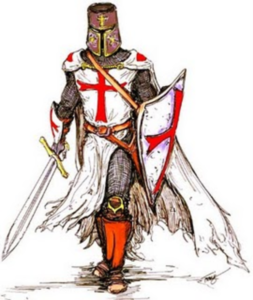 The word knight always makes me think of medieval men in full armor fighting with shields and swords, and maybe that isn’t so far off with the Knights Templar. One thing I didn’t connect to the knights, was Christianity, but maybe I should have. The medieval knights are a little outside my wheelhouse, but I have had an interest in them for a while now, and the Knights Templar are at the top of my list. So, I decided to have a look at exactly what they are, beginning with the Knights Templar.
The word knight always makes me think of medieval men in full armor fighting with shields and swords, and maybe that isn’t so far off with the Knights Templar. One thing I didn’t connect to the knights, was Christianity, but maybe I should have. The medieval knights are a little outside my wheelhouse, but I have had an interest in them for a while now, and the Knights Templar are at the top of my list. So, I decided to have a look at exactly what they are, beginning with the Knights Templar.
After Christian armies captured Jerusalem from Muslim control in 1099 during the Crusades, groups of pilgrims from across Western Europe started visiting the Holy Land. As they traveled, many of them were robbed and killed crossing through Muslim-controlled territories during their journey. A French knight named Hugues de Payens created a military order along with eight relatives and acquaintances, calling it the Poor Fellow-Soldiers of Christ and the Temple of Solomon. Later known simply as the Knights Templar (Knights of the Temple), it was founded in 1118 in Jerusalem, and was a large organization of devout Christians who carried out an important mission: to protect European travelers visiting sites in the Holy Land. The first headquarters of the Knights Templar was located on the site of the Temple of Solomon, and it was to this temple that the organization was dedicated and where it got its name.
Initially, the Knights Templar faced criticism from some religious leaders. There are always those who think the church and any kind of government or military group should not mix, but in 1129, the group received the formal endorsement of the Catholic Church and support from Bernard of Clairvaux, a prominent French abbot. Bernard authored “In Praise of the New Knighthood,” a text that supported the Knights Templar and bolstered their growth. In 1139, Pope Innocent II issued a Papal Bull that allowed the Knights Templar special rights. Among them, the Templars were exempt from paying taxes, permitted to build their own oratories and were held to no one’s authority except the Pope’s.
The Knights Templar quickly set up a network of banks and gained enormous financial influence, with an ability to quickly fund their work. Their banking system allowed religious pilgrims to deposit assets in their home countries and withdraw funds in the Holy Land. The order became known for its austere code of conduct (which included no pointy shoes and no kissing their mothers, rules outlined in “The Rule of the Templars”) and signature style of dress, which featured a white habit emblazoned with a simple red cross. Members swore an oath of poverty, chastity and obedience. They weren’t allowed to drink, gamble or swear. Prayer was essential to their daily life, and the Templars expressed particular adoration for the Virgin Mary.
New chapters of the Knights Templar were established throughout Western Europe as the group grew in size and status. At the height of their influence, the Templars had a sizable fleet of ships, and they owned the Mediterranean island of Cyprus. They served as a primary bank and lending institution to European monarchs and nobles. Though its original purpose was to protect Christiam pilgrims from danger, the Knights Templar later expanded its duties. They became defenders of the Crusader states in the Holy Land and were known as brave, highly skilled warriors. The group developed a reputation as fierce fighters during the Crusades. They were driven by religious zeal and forbidden from retreating unless significantly outnumbered, and I doubt if they would even then. The Templars built numerous castles. They fought, and often won, battles against Islamic armies. Their fearless style of fighting became a model for other military orders. They were quite the group.


Leave a Reply